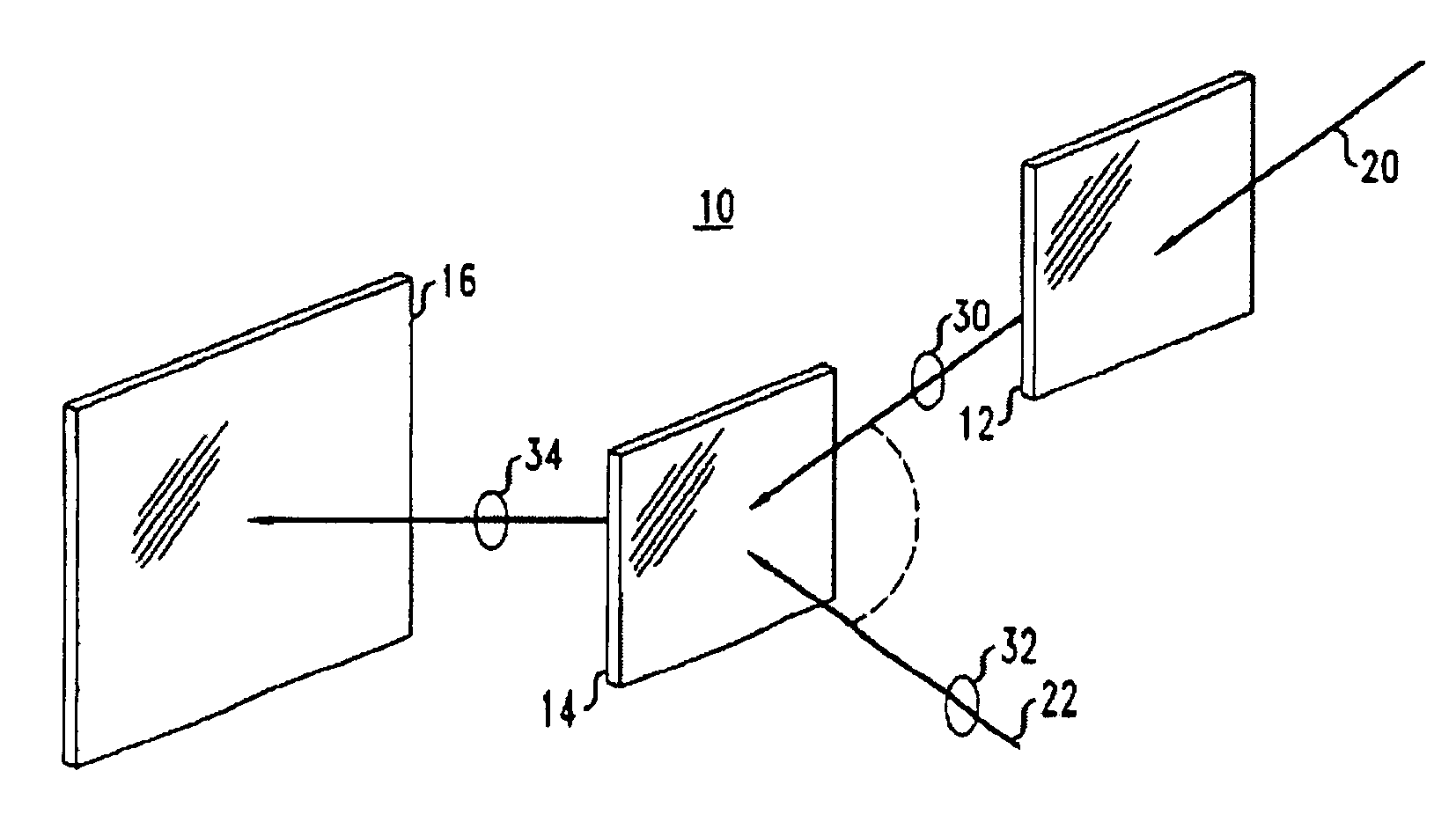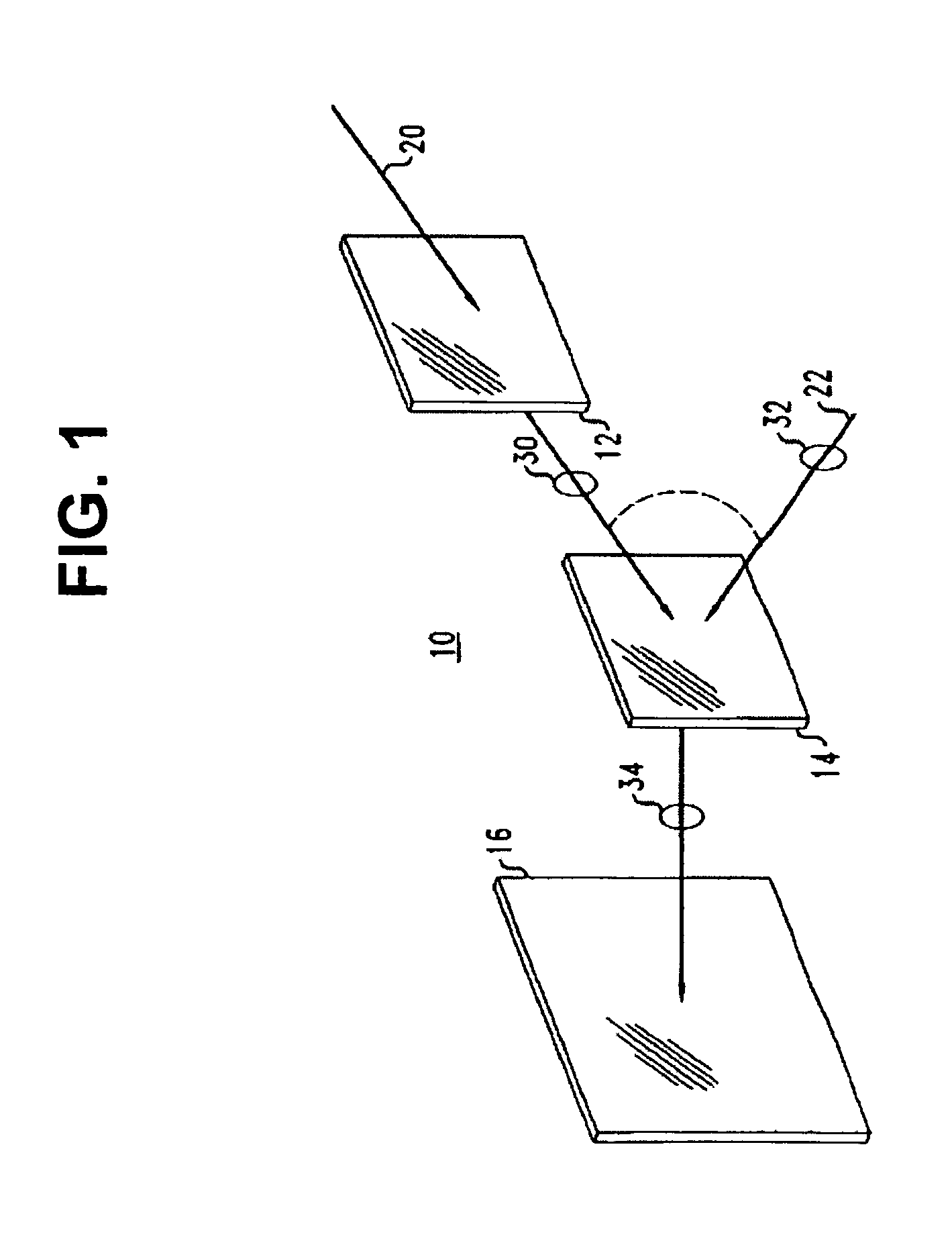Holographic recording medium with control of photopolymerization and dark reactions
a recording medium and photopolymerization technology, applied in the field of holographic recording mediums, can solve the problem of large bragg detuning values of one-component systems
- Summary
- Abstract
- Description
- Claims
- Application Information
AI Technical Summary
Benefits of technology
Problems solved by technology
Method used
Image
Examples
example 1
[0158] The following formulation is used:
Formulation 1IngredientWt. %1,4-Bis(2-thionaphthyl)-2-Butylacrylate2.9Irgacure 784 Photoinitiator0.7WE180 Dicyclohexane Diisocyanate (from Bayer)38.9Glycerol Propoxylate (Mn 1000)56.8Tert-Butyl Hydrogen Peroxide0.3BHT0.2
[0159] Formulation 1 is mixed until homogeneous and then one drop of tin catalyst is added. Matrix samples are made by placing a spacer on a glass slide, then dispensing a portion of the mixture. A second glass slide is placed on top of the dispensed mixture, and the resulting matrix is then allowed to cure. After about 24 hours, the sample is tested on a 532 nm plane wave system by writing 31 angle multiplexed-volume holograms. Formulation 1 is stable at room temperature for at least 4 months and does not overdevelop holograms.
example 2
[0160] The following formulation is used:
Formulation 2IngredientWt. %1,4-Bis(2-thionaphthyl)-2-Butylacrylate3.9Triphenylphosphine oxide (TPO) Photoinitiator0.3WE180 Dicyclohexane Diisocyanate (from Bayer)38.9Glycerol Propoxylate (Mn 1000)56.8Nitrobenzene0.1
[0161] One drop of tin catalyst is added to formulation 2 and matrix samples are prepared as in Example 1. The samples are tested on a 405 nm plane wave table by writing 31 angle multiplexed-volume holograms. When the nitrobenzene retarder is absent from the formulation, it is found that the matrix samples prepared therefrom are not suitable for high density data storage because the gratings become distorted due to overdevelopment (i.e., polymerization continued after recording).
example 3
[0162] The following formulation is used:
Formulation 3IngredientWt. %1,4-Bis(2-thionaphthyl)-2-Butylacrylate4.0TPO Photoinitiator0.3WE180 Dicyclohexane Diisocyanate (from Bayer)38.7Glycerol Propoxylate (Mn 1000)56.02-(1,2-Ethyldiol)-Nitrobenzene1.0
[0163] One drop of tin catalyst is added to formulation 3 and matrix samples are prepared as in Example 1. The 2-(1,2-ethyldiol)-nitrobenzene becomes pendant or attached to the matrix during the cure. The samples are tested on a 405 nm plane wave table by writing 31 angle multiplexed-volume holograms. It is found that more photopolymerization retarder (i.e., 2-(1,2-ethyldiol)-nitrobenzene) is needed than the nitrobenzene of formulation 2 to prevent overdevelopment of holograms. For example, when less than 1 wt % of 2-(1,2-ethyldiol)-nitrobenzene is used, overdevelopment of holograms occurs. However, at room temperature, the archival life of matrix samples prepared from formulation 3 is greatly improved relative to those prepared from for...
PUM
 Login to View More
Login to View More Abstract
Description
Claims
Application Information
 Login to View More
Login to View More - R&D
- Intellectual Property
- Life Sciences
- Materials
- Tech Scout
- Unparalleled Data Quality
- Higher Quality Content
- 60% Fewer Hallucinations
Browse by: Latest US Patents, China's latest patents, Technical Efficacy Thesaurus, Application Domain, Technology Topic, Popular Technical Reports.
© 2025 PatSnap. All rights reserved.Legal|Privacy policy|Modern Slavery Act Transparency Statement|Sitemap|About US| Contact US: help@patsnap.com



